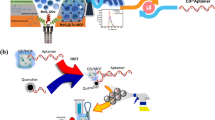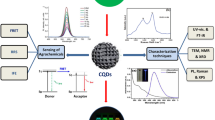Abstract
New nitrogen and fluorine co-doped carbon dots were synthesized and used as a dual function fluorescent probe for silicon and mercury ions. The size of CDs was 10 nm. At optimum conditions (pH = 13, λex = 360 nm, and λem = 518 nm), the detection limit (DL) of silicon was 16.6 nM. Linear calibration was observed in the range of 0.8–35 µM. This fluorescence probe for silicon detection is presented for the first time and had the lowest detection limit in comparison with different previously reported techniques. In addition to the above property, these co-doped carbon dots had the second function as a fluorescence probe for mercury detection at pH = 8. The DL for mercury was 38 nM. The performance of this probe was also compared with other co-doped carbon dots. Excellent sensitivity and selectivity, simple method, low-cost materials, and applicability in real sample analysis are advantages of this dual function fluorescence probe.





Similar content being viewed by others
Data Availability
The data that support the findings of this study are available from the corresponding author, upon reasonable request.
Code Availability
Not applicable.
References
Dejneka W, Łukasiak J (2003) Determination of total and bioavailable silicon in selected food stuffs. Food Control 14:193–196
Rahier AH, Lunardi S, Nicolle F, George SM (2010) Low-level determination of silicon in steels by anodic stripping voltammetry on a hanging mercury drop electrode. Talanta 82:1839–1844
Pohl P, Vorapalawut N, Bouyssiere B, Lobinski R (2010) Trace-level determination and insight in speciation of silicon in petrochemical samples by flow-injection high resolution ICP MS and HPLC-high resolution ICP MS. Anal At Spectrom 25:1461–1466
Mukhtar A, Limbeck A (2009) A new approach for the determination of silicon in airborne particulate matter using electrothermal atomic absorption spectrometry. Anal Chim Acta 646:17–22
Maraschi F, Sturini M, Speltini A, Orio F, Profumo A, Pierucci G (2012) Silicon determination in human ventricular whole blood: A possible marker of drowning. Anal Biochem 426:142–146
Proost J, Santoro R, Abu Jeriban S, Guiot I (2008) Spectrophotometric determination of silicon in ultrapure, dilute hydrofluoric acid solutions. Microchem J 89:48–51
Pedrozo-Penafiel MJ, Doyle A, Mendes LAN, Tristao MLB, Saavedra A, Aucelio RQ (2019) Methods for the determination of silicon and aluminum in fuel oils and in crude oils by X-ray fluorescence spectrometry. Fuel 243:493–500
Gómez-Nieto B, Gismera MJ, Sevilla MT, Cofrades S, Freire M, Procopio JR (2018) Straightforward silicon determination in water-in-oil-in-water emulsions used for silicon supplementations in food by high-resolution continuum source flame atomic absorption spectrometry. Spectrochim Acta B 148:44–50
Nikonorov VV, Nikitina TG (2016) Capillary electrophoretic determination of silicon in plants. Microchem J 127:7–10
Hou S, Ding M, Zhu J (2008) Simultaneous determination of silicon and phosphorus in soil and plants by reversed-phase ion-pair chromatography. Talanta 75:178–182
Singh RK, Kumar R, Singh DP, Savu R, Moshkalev SA (2019) Progress in microwave-assisted synthesis of quantum dots (graphene/carbon/semiconducting) for bioapplications: a review. Mater Today Chem 12:282–314
de Medeiros TV, Manioudakis J, Noun F, Macairan JR, Victoria F, Naccache R (2019) Microwave-assisted synthesis of carbon dots and their applications. J Mater Chem C 7:7175–7195
Wu Z, Feng MK, Chen XX, Tang XJ (2016) N-dots as a photoluminescent probe for the rapid and selective detection of Hg2+ and Ag+ in aqueous solution. J Mater Chem B 4:2086–2089
Zhang R, Chen W (2014) Nitrogen-doped carbon quantum dots: facile synthesis and application as a turn-off fluorescent probe for detection of Hg2+ ions. Biosens Bioelectron 55:83–90
Li DY, Wang SP, Azad F, Su SC (2020) Single-step synthesis of polychromatic carbon quantum dots for macroscopic detection of Hg2+. Ecotox Environ Safe 190:110141
Singh VK, Singh V, Yadav PK, Chandra S, Bano D, Koch B, Talat M, Hasan SH (2019) Nitrogen doped fluorescent carbon quantum dots for on-off-on detection of Hg2+ and glutathione in aqueous medium: Live cell imaging and implication logic gate operation. J Photoch Photobio A 384:112042
Sun D, Ban R, Zhang PH, Wu GH, Zhang JR, Zhu JJ (2013) Hair fiber as a precursor for synthesizing of sulfur- and nitrogen-co doped carbon dots with tunable luminescence properties. Carbon 64:424–434
Wang Y, Kim SH, Feng L (2015) Highly luminescent N, S-co-doped carbon dots and their direct use as mercury (II) sensor. Anal Chim Acta 890:134–142
Tabaraki R, Abdi O (2018) Green and simple turn off/on fluorescence sensor for mercury (II), cysteine and histidine. J Mol Liq 251:77–82
Tabaraki R, Sadeghinejad N (2018) Microwave assisted synthesis of doped carbon dots and their application as green and simple turn off–on fluorescent sensor for mercury (II) and iodide in environmental samples. Ecotox Environ Safe 153:101–106
Ye Q, Yan F, Shi D, Zheng T, Wang Y, Zhou X, Chen L (2016) N, B-doped carbon dots as a sensitive fluorescence probe for Hg2+ ions and 2,4,6-trinitrophenol detection for bioimaging. J Photoch Photobio B 162:1–13
Xu Q, Li B, Ye Y, Cai W, Li W, Yang C, Chen Y, Xu M, Li N, Zheng X, Street J, Luo Y, Cai L (2018) Synthesis, mechanical investigation, and application of nitrogen and phosphorus co-doped carbon dots with a high photoluminescent quantum yield. Nano Res 11:3691–3701
Tabaraki R, Abdi O, Yousefipour S (2017) Green and selective fluorescent sensor for detection of Sn (IV) and Mo (VI) based on boron and nitrogen-co-doped carbon dots. J Fluoresc 27:651–657
Luo TY, He X, Zhang J, Chen P, Liu YH, Wang HJ, Yu XQ (2018) Photoluminescent F-doped carbon dots prepared by ring-opening reaction for gene delivery and cell imaging. RSC Adv 8:6053–6062
Hong D, Deng X, Liang J, Li J, Tao Y, Tan K (2019) One-step hydrothermal synthesis of down/up-conversion luminescence F-doped carbon quantum dots for label-free detection of Fe3+. Microchem J 151:104217
Author information
Authors and Affiliations
Contributions
All authors have read and agreed to the published version of the manuscript.
Corresponding author
Ethics declarations
Conflict of Interest
The authors declare that they have no competing.
Additional information
Publisher’s Note
Springer Nature remains neutral with regard to jurisdictional claims in published maps and institutional affiliations.
Rights and permissions
About this article
Cite this article
Tabaraki, R., Rahmatinya, Z. Bifunctional Nitrogen and Fluorine Co‐doped Carbon Dots as Fluorescence Probe for Silicon and Mercury by pH Switching. J Fluoresc 31, 881–887 (2021). https://doi.org/10.1007/s10895-021-02709-0
Received:
Accepted:
Published:
Issue Date:
DOI: https://doi.org/10.1007/s10895-021-02709-0




